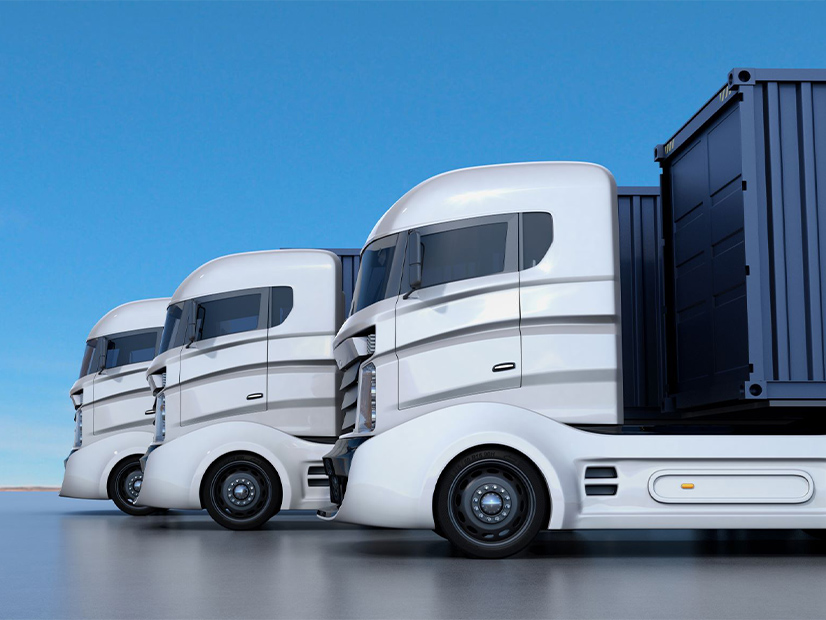
The EPA on Friday approved a waiver for California’s Advanced Clean Trucks regulation, clearing the way for the state to launch the zero-emission program for medium- and heavy-duty trucks starting with model year 2024.
The regulation will require truck manufacturers to sell an increasing percentage of zero-emission medium- and heavy-duty trucks in the state from 2024 through 2035.
The zero-emission vehicle sales requirements will also apply in states that have adopted California’s Advanced Clean Trucks (ACT) regulation, including Washington, Oregon, New York, New Jersey, Massachusetts and Vermont.
California Gov. Gavin Newsom on Friday called the EPA decision “a big deal for climate action.” Newsom said California will be the first government in the world requiring zero-emission trucks.
“We’re leading the charge to get dirty trucks and buses — the most polluting vehicles — off our streets, and other states and countries are lining up to follow our lead around the world,” Newsom said in a statement.
The EPA waiver was needed because air quality standards in the ACT differ from those of the federal government. California is allowed to adopt and enforce its own vehicle emissions requirements if they exceed federal standards and EPA grants a waiver.
“Under the Clean Air Act, California has long-standing authority to address pollution from cars and trucks,” EPA Administrator Michael Regan said in a statement on Friday. “Today’s announcement allows the state to take additional steps in reducing their transportation emissions through these new regulatory actions.”
Mixed Reactions
The American Trucking Associations (ATA) on Friday criticized the EPA decision, saying it allowed California to create a “regulatory patchwork.”
“This isn’t the United States of California,” ATA CEO Chris Spear said in a statement.
Spear said the regulation’s “technologically infeasible rules” and “unworkable and unrealistic timelines” were setting the stage for a supply-chain crisis.
But environmental groups welcomed the EPA decision.
Heavy-duty trucks account for only about 10% of vehicles on the nation’s roads but have an oversized impact on air pollution, according to the Environmental Defense Fund. The impacts are felt especially in low-income areas and in communities of color, EDF said.
“The Advanced Clean Trucks Rule will save lives, save money for truckers and fleets, save the state billions of dollars in health care costs, and help create thousands of new jobs,” EDF clean transportation attorney Andy Su said in a statement.
Three Waiver Requests
The California Air Resources Board adopted the Advanced Clean Trucks regulation in June 2020. CARB has said that its rule will drive technology development and investment in zero-emission trucks.
In deciding whether to grant a waiver for ACT, the EPA held a virtual public hearing in June 2022 and accepted written comments through Aug. 2.
EPA also granted a waiver on Friday for a CARB regulation that extends emissions warranty periods for heavy-duty diesel trucks in model years 2022 and later.
EPA has yet to decide on a third waiver request from CARB. The Heavy-Duty Low NOx Omnibus Regulation, which CARB approved in August 2020, aims to reduce emissions of nitrogen oxides from trucks. The rule sets new standards starting with the 2024 model year and tightens the standards further in 2027.
CARB has asked EPA for more time before EPA acts on the low NOx waiver request, the federal agency said.
Increasing Sales Requirement
In August, CARB adopted the Advanced Clean Cars II regulation, banning the sale of gas-powered cars in 2035. The rule allows some sales of plug-in hybrid vehicles at that time. (See Calif. Adopts Rule Banning Gas-powered Car Sales in 2035.) CARB must still receive a waiver from the EPA to enforce those regulations.
Advanced Clean Trucks isn’t a total ban on gas-powered truck sales. Zero-emission sales requirements vary by vehicle class. For Class 2b and 3 trucks, such as step vans and city delivery trucks, the rule requires 5% ZEV sales in 2024, increasing to 55% in 2035.
For class 4 to 8 trucks, such as large delivery trucks, school buses and beverage trucks, the 9% requirement for zero-emission new vehicle sales in 2024 grows to 75% in 2035. ZEV sales requirements for Class 7 and 8 tractors range from 5% in 2024 to 40% in 2035.
ACT also includes a credit system in which a truck manufacturer may sell ZEV credits they earn to other manufacturers. Manufacturers may receive early credits for zero-emission trucks sold starting with model year 2021, and certain hybrid electric trucks may earn partial credits.
Under ACT, zero-emission sales requirements for trucks don’t increase after 2035. But a 2020 executive order from Newsom set a goal for all medium- and heavy-duty vehicles in the state to be zero-emission by 2045 where feasible.
In addition to ACT, CARB is expected to vote during its April 27 meeting on adoption of another zero-emission truck regulation, Advanced Clean Fleets.
The regulation would require some or all new trucks added to certain types of fleets to be zero-emission starting in January 2024. The three types of fleets covered are drayage, state and local, and fleets deemed high priority.
